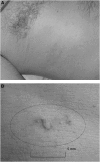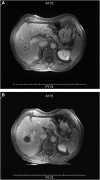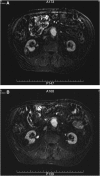The safety and feasibility of extracorporeal high-intensity focused ultrasound (HIFU) for the treatment of liver and kidney tumours in a Western population
- PMID: 16189519
- PMCID: PMC2361666
- DOI: 10.1038/sj.bjc.6602803
The safety and feasibility of extracorporeal high-intensity focused ultrasound (HIFU) for the treatment of liver and kidney tumours in a Western population
Abstract
High-intensity focused ultrasound (HIFU) provides a potential noninvasive alternative to conventional therapies. We report our preliminary experience from clinical trials designed to evaluate the safety and feasibility of a novel, extracorporeal HIFU device for the treatment of liver and kidney tumours in a Western population. The extracorporeal, ultrasound-guided Model-JC Tumor Therapy System (HAIFU Technology Company, China) has been used to treat 30 patients according to four trial protocols. Patients with hepatic or renal tumours underwent a single therapeutic HIFU session under general anaesthesia. Magnetic resonance imaging 12 days after treatment provided assessment of response. The patients were subdivided into those followed up with further imaging alone or those undergoing surgical resection of their tumours, which enabled both radiological and histological assessment. HIFU exposure resulted in discrete zones of ablation in 25 of 27 evaluable patients (93%). Ablation of liver tumours was achieved more consistently than for kidney tumours (100 vs 67%, assessed radiologically). The adverse event profile was favourable when compared to more invasive techniques. HIFU treatment of liver and kidney tumours in a Western population is both safe and feasible. These findings have significant implications for future noninvasive image-guided tumour ablation.
Figures




References
-
- Blana A, Walter B, Rogenhofer S, Wieland WF (2004) High-intensity focused ultrasound for the treatment of localized prostate cancer: 5-year experience. Urology 63: 297–300 - PubMed
-
- den Brok MH, Sutmuller RP, van der Voort R, Bennink EJ, Figdor CG, Ruers TJ, Adema GJ (2004) In situ tumor ablation creates an antigen source for the generation of antitumor immunity. Cancer Res 64: 4024–4029 - PubMed
-
- Gervais DA, McGovern FJ, Arellano RS, McDougal WS, Mueller PR (2003) Renal cell carcinoma: clinical experience and technical success with radio-frequency ablation of 42 tumors. Radiology 226: 417–424 - PubMed
-
- Goldberg SN, Charboneau JW, Dodd III GD, Dupuy DE, Gervais DA, Gillams AR, Kane RA, Lee Jr FT, Livraghi T, McGahan JP, Rhim H, Silverman SG, Solbiati L, Vogl TJ, Wood BJ (2003) Image-guided tumor ablation: proposal for standardization of terms and reporting criteria. Radiology 228: 335–345 - PubMed
-
- Hill CR, Rivens IH, Vaughan MG, ter Haar G (1994) Lesion development in focused ultrasound surgery: a general model. Ultrasound Med Biol 20: 259–269 - PubMed
Publication types
MeSH terms
LinkOut - more resources
Full Text Sources
Other Literature Sources
Medical

